
The spectral bat, also called the great false vampire bat or Linnaeus's false vampire bat, is a large, carnivorous leaf-nosed bat found in Mexico, Central America, and South America. It is the only member of the genus Vampyrum; its closest living relative is the big-eared woolly bat. It is the largest bat species in the New World, as well as the largest carnivorous bat: its wingspan is 0.7–1.0 m (2.3–3.3 ft). It has a robust skull and teeth, with which it delivers a powerful bite to kill its prey. Birds are frequent prey items, though it may also consume rodents, insects, and other bats.
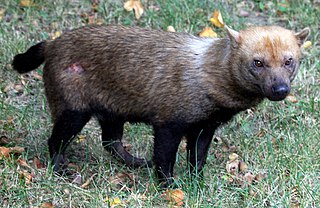
The bush dog is a canine found in Central and South America. In spite of its extensive range, it is very rare in most areas except in Suriname, Guyana and Peru; it was first identified by Peter Wilhelm Lund from fossils in Brazilian caves and was believed to be extinct. The bush dog is the only living species in the genus Speothos, and genetic evidence suggests that its closest living relative is the maned wolf of central South America or the African wild dog. The species is listed as Near Threatened by the IUCN.
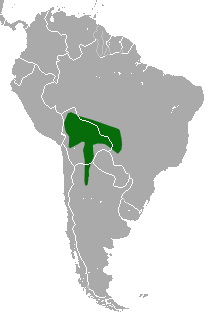
The white-bellied woolly mouse opossum is a small pouchless marsupial of the family Didelphidae. It was formerly assigned to the genus Micoureus, which was made a subgenus of Marmosa in 2009. The specific epithet was given in honour of Constance Sladen, wife of the naturalist Percy Sladen. She funded the 1902 expedition which collected the type specimen.

The brown tinamou is a brownish ground bird found in humid lowland and montane forest in tropical and subtropical South America.

The bare-tailed woolly opossum is an opossum from South America. It was first described by Swedish zoologist Carl Linnaeus in 1758. The bare-tailed woolly opossum is characterized by a gray head, brown to gray coat, orange to gray underside and a partially naked tail. It is nocturnal and solitary; there is hardly any social interaction except between mother and juveniles and in mating pairs. The opossum constructs nests in tree cavities, and its litter size ranges from one to seven. Gestation lasts 25 days, and the juveniles exit the pouch after three months; weaning occurs a month later. The bare-tailed woolly opossum inhabits subtropical forests, rainforests, secondary forests, and plantations; its range extends from northern Venezuela to northeastern and southcentral Brazil. The IUCN classifies this opossum as least concern.

The brown-eared woolly opossum, also known as the western woolly opossum, is an opossum from South America. It was first described by German naturalist Ignaz von Olfers in 1818. The opossum is characterized by a brown to reddish brown coat and similarly colored limbs, yellow to orange underbelly, hairless, brown ears with a hint of pink, and a tail furred on the back for up to half of its length. The brown-eared woolly opossum is nocturnal, solitary and omnivorous. The IUCN lists it as least concern.

The big naked-backed bat, is a bat species from South and Central America.

The greater dog-like bat is a bat species from Central America and South America. It is found from southern Mexico through Brazil and Peru.
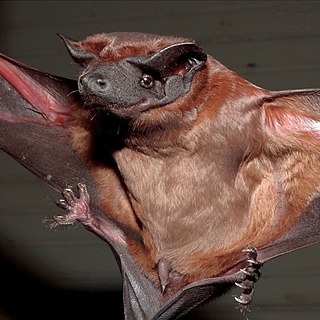
The cinnamon dog-faced bat, is a South American bat species of the family Molossidae. It is found in northern and central South America.

The dwarf dog-faced bat is a species of free-tailed bat from South America. It is found in Argentina, Bolivia, Brazil, Colombia, Ecuador, Guyana, Peru, Paraguay and Uruguay, typically at lower elevations. It is one of two species in the genus Molossops, the other being the rufous dog-faced bat. Three subspecies are often recognized, though mammalogist Judith Eger considers it monotypic with no subspecies. It is a small free-tailed bat, with a forearm length of 28.9–32.5 mm (1.14–1.28 in) and a weight of 5–8 g (0.18–0.28 oz); males are larger than females. It is brown, with paler belly fur and darker back fur. Its wings are unusual for a free-tailed bat, with exceptionally broad wingtips. Additionally, it has low wing loading, meaning that it has a large wing surface area relative to its body weight. Therefore, it flies more similarly to a vesper bat than to other species in its own family. As it forages at night for its insect prey, including moths, beetles, and others, it uses two kinds of frequency-modulated echolocation calls: one type is to navigate in open areas and to search for prey, while the other type is used for navigating in cluttered areas or while approaching a prey item.
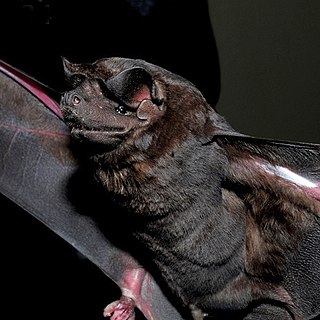
The black mastiff bat is a bat species. It ranges from the northern region of South America, most of Central America and parts of southern Mexico.

The Para dog-faced bat, also called the brown dog-faced bat, is a South American bat species of the family Molossidae. It is found in Panama, Colombia, Ecuador, Peru, Venezuela, Guyana, Surinam, French Guiana, Brazil, and northern Argentina.

The white-throated round-eared bat is a South and Central American bat species found from Honduras to Bolivia, Paraguay and Brazil. It creates roosts inside the nests of the termite, Nasutitermes corniger. It thrives on a mainly insect-based diet, focusing on the surfaces of foliage to hunt, and also eats fruit and pollen. It has a very wide range and is a common species over much of that range, so the International Union for Conservation of Nature has assessed its conservation status as being of "least concern".

Euryoryzomys nitidus, also known as the elegant oryzomys or elegant rice rat, is a rodent species in the family Cricetidae. Previously it was known as Oryzomys nitidus, but it is not closely related to Oryzomys as that genus is now constructed. Its range includes Bolivia, Brazil and Peru to the east of the Andes, in lowland tropical rainforest as well as forest in the eastern foothills of the mountains, at elevations from 50 to 2,000 m.
Neacomys spinosus, also known as the common neacomys, common bristly mouse, or bristly mouse, is a nocturnal rodent species from South America in the genus Neacomys. It is found in Bolivia, Brazil, Colombia, Ecuador and Peru, where it often lives in transition areas between lowland forest and open regions. Its diet consists of insects, seeds and fruit.
The Amazonian hocicudo is a species of rodent in the family Cricetidae from South America. It is found in the Amazon basin in Brazil where it lives in moist lowland forest. It is a common species with a large range and is rated by the IUCN as being of "least concern".

Greenhall's dog-faced bat is a South American bat species of the family Molossidae. It is found in Colombia, Peru, Ecuador, Venezuela, the Guianas, northeastern Brazil and Trinidad.
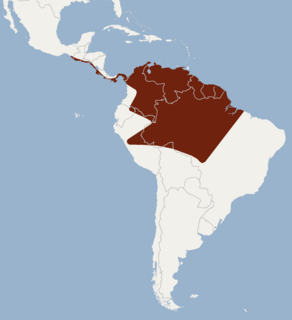
The Coiban mastiff bat is a species of bat in the family Molossidae. Its range extends from Chiapas in southern Mexico to Mato Grosso in Brazil, including Peru, Ecuador, Venezuela, Panama, Costa Rica and El Salvador. The taxonomic status of the populations in Central America is uncertain. The species is insectivorous and is known from a variety of forest habitats at elevations from near sea level to 1300 m.

Parides lysander, the Lysander cattleheart, is a species of butterfly in the family Papilionidae. It is found in the Neotropical realm.
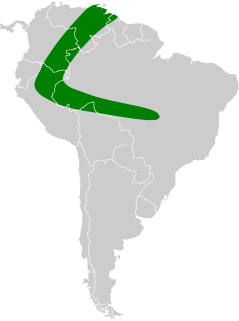
Cynomops milleri is a species of bat that is native to South America. It was previously considered a subspecies of the Para dog-faced bat. It is considered a small- to medium-sized member of its genus. It is classified as least concern by the International Union for Conservation of Nature because it appears to be common and widespread. It is found in Venezuela, French Guiana, Guyana, Suriname, Brazil, and Peru.



















